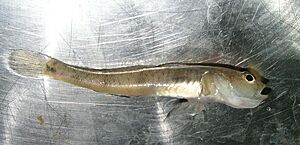Sand goby facts for kids
Quick facts for kids Sand goby |
|
|---|---|
 |
|
| Conservation status | |
| Scientific classification | |
| Synonyms | |
|
The sand goby (Pomatoschistus minutus) is a small fish found in the waters around Europe. It is also known by other names like polewig or pollybait. This fish lives in both salty ocean water (marine) and slightly salty water (brackish). You can find them from the Baltic Sea all the way through the Mediterranean Sea to the Black Sea.
Sand gobies prefer sandy or muddy areas close to shore. They can live at depths from about 4 meters (13 feet) down to 200 meters (656 feet). These fish are quite small, usually growing up to 11 centimeters (4.3 inches) long. Sometimes, you can even see them in public aquariums.
The sand goby has a sandy color, which helps it blend in with the seabed. It has darker marks on its sides and a creamy-white belly. When it's time to breed, male sand gobies get a special blue spot on their first dorsal fin, which is ringed with white. This fish has a slim body, and its head makes up about a quarter of its total length.
Contents
What Does a Sand Goby Look Like?
The sand goby has two fins on its back, called dorsal fins. There is a wider space between these two fins compared to its relative, the common goby. The front dorsal fin has six soft spines, and the back one has eight to eleven soft rays. Its pelvic fins, which are near its belly, are joined together with its anal fins.
This fish has many scales, about 58 to 72 along its side (called the lateral line). These scales are smaller than those on a common goby. The tail fin, or caudal fin, is rounded. Male sand gobies have a clear dark spot on their front dorsal fin. Both male and female gobies have a black patch near their tail.
Their overall color is sandy brown with faint dark spots and patterns on their back. Their pale fins also have dark stripes. During the breeding season, the male's color gets darker, and his fins become more colorful. On average, sand gobies are about 4 to 5 centimeters (1.6 to 2 inches) long.
How Do Sand Gobies Behave?
Sand gobies usually live in deeper waters than common gobies. They are excellent at camouflage, meaning they can blend in very well with their surroundings. They often lie still on the seabed, waiting for their food to come close.
What Do Sand Gobies Eat?
Sand gobies eat small creatures that live on the seabed. Their favorite foods include tiny invertebrates, especially small crustaceans called amphipods.
Sand Goby Reproduction and Life Cycle
Sand gobies breed during the summer months. The male fish is responsible for building a nest. He usually finds a shell and, if needed, can even turn it over to create a safe spot. The female then lays her eggs on the underside of this shell. The male guards the eggs until they hatch.
Images for kids



